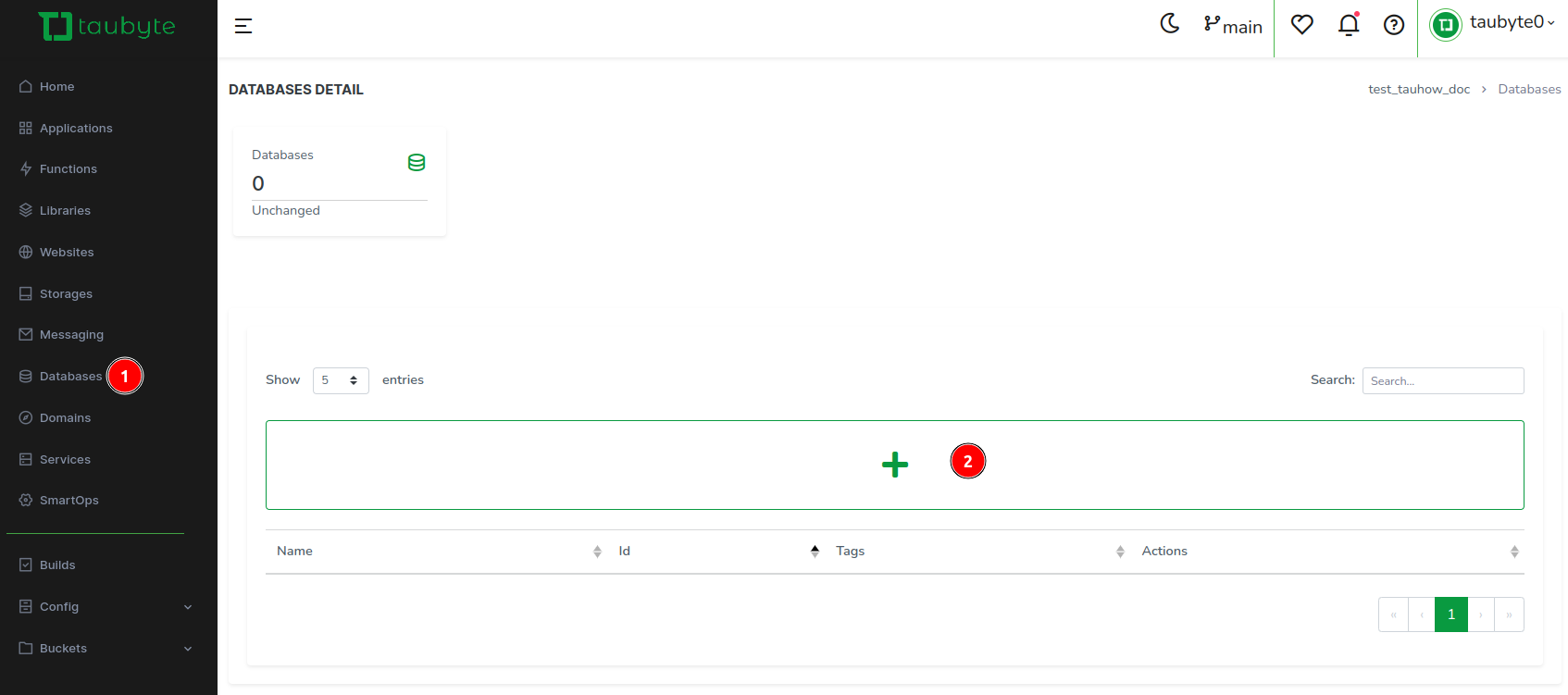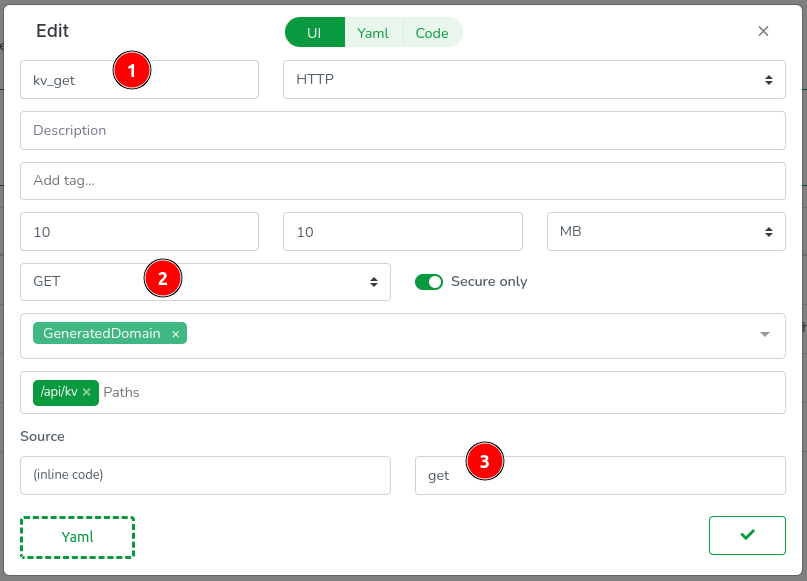Databases
You've already set up your first project, created a serverless function, and launched a website. Now, let's take it up a notch by integrating a database into your application.
Creating the Database¶
First, navigate to Database in the side menu and click the + button.

Name the database example_kv_store. As a matcher, use /example/kv. Set replication to min=1, max=2. Set the size to 100MB and validate.

💡 Note: Just like storage, the matcher can be any string and even a regular expression. There's no restrictions on the matcher but I prefer to use a path like
/example/kv.
Now, you should see your new database in the list.

Changes are currently only saved locally in your browser's virtual filesystem. Click on the green button on the bottom right corner. Review the changes, add a commit message, and click on Push.

Use the Database¶
Taubyte databasees are instantiated on the fly when you first use it. This is why you can use regular expressions as a matcher. For example, if we used /profile/history/[^/]+, opening /profile/history/userA would create a database just for that user.
Let's create two functions that will use the database: one to store a key/value and another to get the value given a key. For detailed steps on how to create a function, see Create a function.
Setting a Key¶
Start with the upload function. Go to Functions and click on the + button. Create a new function named kv_set. Ensure it has enough memory; 10MB should be more than enough. Set the method to POST, use the generated domain, set the path to /api/kv, and set the entry point to set.

Switch to the code view and add the following code:
package lib
import (
"encoding/json"
"github.com/taubyte/go-sdk/database"
"github.com/taubyte/go-sdk/event"
http "github.com/taubyte/go-sdk/http/event"
)
func fail(h http.Event, err error, code int) uint32 {
h.Write([]byte(err.Error()))
h.Return(code)
return 1
}
type Req struct {
Key string `json:"key"`
Value string `json:"value"`
}
//export set
func set(e event.Event) uint32 {
h, err := e.HTTP()
if err != nil {
return 1
}
// (Create) & Open the database
db, err := database.New("/example/kv")
if err != nil {
return fail(h, err, 500)
}
// Decode the request body
reqDec := json.NewDecoder(h.Body())
defer h.Body().Close()
// Decode the request body
var req Req
err = reqDec.Decode(&req)
if err != nil {
return fail(h, err, 500)
}
// Put the key/value into the database
err = db.Put(req.Key, []byte(req.Value))
if err != nil {
return fail(h, err, 500)
}
return 0
}
Validate the new function, push the changes then go back to your terminal in order to trigger build:
Once the build is done, you can test the function by sending a POST request to the endpoint:
curl -X POST http://evy8manx0.blackhole.localtau:11005/api/kv -H "Content-Type: application/json" -d '{
"key": "message",
"value": "hello world!"
}'
💡 Note: Replace
evy8manx0.blackhole.localtauwith your own domain and 11005 with your own port.
Unless the curl fails, we now have a key message that contains hello world! in our database.
Getting a Key¶
Let's create a function to get the value given a key. To save time, you can use the clone icon to clone the kv_set function.

Edit the freshly cloned function, name it kv_get, set the method to GET, and set the entry point to get.

Switch to the code view and add the following code:
package lib
import (
"github.com/taubyte/go-sdk/database"
"github.com/taubyte/go-sdk/event"
http "github.com/taubyte/go-sdk/http/event"
)
func fail(h http.Event, err error, code int) uint32 {
h.Write([]byte(err.Error()))
h.Return(code)
return 1
}
//export get
func get(e event.Event) uint32 {
h, err := e.HTTP()
if err != nil {
return 1
}
key, err := h.Query().Get("key")
if err != nil {
return fail(h, err, 400)
}
db, err := database.New("/example/kv")
if err != nil {
return fail(h, err, 500)
}
value, err := db.Get(key)
if err != nil {
return fail(h, err, 500)
}
h.Write(value)
h.Return(200)
return 0
}
Same as for the previous function: validate, push then trigger build:
Wait for the build to finish, then test the function by sending a GET request to the endpoint:
Output:
On chrome, you can also see the performance of the function:

Congratulations! You've now created and used a database in your application.